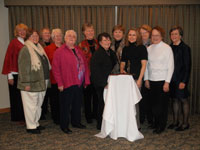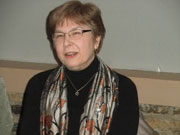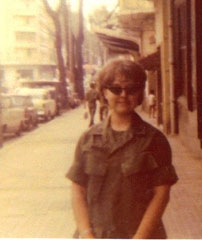Women Who Served
Meet some of the women who served in or during the Vietnam War. Some of them are featured in the book, some are not. Some of them were nurses, some of them served in the enlisted ranks. Some of the nurses served in military hospitals in Vietnam, some of them worked at hospitals where wounded GIs were sent from Vietnam. Some of them were military women, some of them went to Vietnam as civilians. All of them served.
The Women of Sisterhood of War
Kay Bauer, Navy Nurse Corps | Vietnamese Provincial Hospital, Rach Gia, 1966-1967
Mary Breed, Army Nurse Corps | 95th Evacuation Hospital, Da Nang | 18th Surgical Hospital, Quang Tri, 1970-1971
Valerie Buchan, Army Nurse Corps | 12th Evacuation Hospital, Cu Chi, 1968-1969
Mary Beth Crowley,
Army Nurse Corps |
17th Field Hospital, An Khe
67th Evacuation Hospital, Qui Nhon,
1970-1971
Penny Kettlewell,
Army Nurse Corps |
67th Evacuation Hospital, Qui Nhon,
1967-1968
24th Evacuation Hospital, Long Binh, 1970-1971
Lynn Kohl, Army Nurse Corp | 71st Evacuation Hospital, Pleiku, 1969-1970
Joan Paulson, Army Nurse Corps | 67th Evacuation Hospital, Qui Nhon, 1967-1968
Ann Rudolph, Army Nurse Corps | 93rd Evacuation Hospital, Long Binhm, 1965-1966
Mary O’Brien Tyrrell, Navy Nurse Corps | U.S. Naval Hospital, Guam, 1967-1968
Beyond Sisterhood of War: They Also Served
Lucie Ferrell, Navy Nurse Corps | U.S. Naval Hospital, San Diego, 1966-1968
Mary Glaudel-DeZurik, Marine Corp | Military Assistance Command, Vietnam, 1967-68
Jennifer Wilson | 3rd Field Hospital, Saigon, 1969-1970
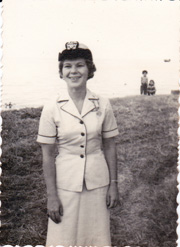 Kay Bauer grew up with her thirteen brothers and sisters in St. Paul. She earned her four-year nursing degree from the College of St. Catherine. The Navy Nurse Corps paid for her final year of nursing school, and Kay received her commission upon graduating in 1959. After spending a number of years nursing for the Navy, Kay requested assignment to Vietnam and arrived there in January 1966. She was part of a Forward Surgical Team assigned to a Vietnamese provincial hospital in Rach Gia, in southernmost South Vietnam. She worked closely with her colleagues, both American and Vietnamese, in a hospital that had no running water or air conditioning. She remained in the Navy after she returned from Vietnam in early 1967, dedicating thirty-five years of her life to the military. Kay was instrumental in forming the nurses PTSD support group and is fondly referred to as “the Admiral” by her sister veterans.
Kay Bauer grew up with her thirteen brothers and sisters in St. Paul. She earned her four-year nursing degree from the College of St. Catherine. The Navy Nurse Corps paid for her final year of nursing school, and Kay received her commission upon graduating in 1959. After spending a number of years nursing for the Navy, Kay requested assignment to Vietnam and arrived there in January 1966. She was part of a Forward Surgical Team assigned to a Vietnamese provincial hospital in Rach Gia, in southernmost South Vietnam. She worked closely with her colleagues, both American and Vietnamese, in a hospital that had no running water or air conditioning. She remained in the Navy after she returned from Vietnam in early 1967, dedicating thirty-five years of her life to the military. Kay was instrumental in forming the nurses PTSD support group and is fondly referred to as “the Admiral” by her sister veterans.
Kay now lives in Coon Rapids, Minnesota, with her husband Vern. They have six wonderful grandchildren and two really great sons and daughters-in-law. Listen to Kay Bauer interviewed here in the “Voices of Minnesota” collection of oral histories at the Minnesota Historical Society: http://www.mnhs.org/media/news/5046
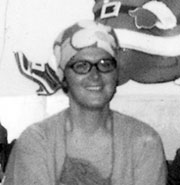 Mary Breed grew up in the Mississippi Courts, a North Minneapolis housing development for soldiers returning from World War II, before she and her family moved to Brooklyn Center. Her father had served in World War II and in 1968, while she was in nursing school at Swedish Hospital, her older brother was sent to Vietnam. Upon his return to the U.S., Mary’s brother mentioned that the military needed nurses in Vietnam. That, combined with visits from military recruiters to her nursing class, convinced her she should offer her services to wounded soldiers. She graduated from nursing school in 1969 and arrived in Bien Hoa, Vietnam, on September 5, 1970. She worked as an OR nurse at the 95th Evac Hospital in DaNang and the 18th Surgical Hospital in Quang Tri. On Christmas Eve at the 95th, the corpsmen with whom she worked gave her a mixed tape of her favorite songs, inscribed with the words, “To our Mom Breed…sweet thoughts for those who care.” While at Quang Tri, Mary received word that her father had died. She returned to the U.S. with a heavy heart and the loving support of the guys in the Graves Registration Unit who had taken up a collection to help her pay for her travel back to Minneapolis. After her separation from service, Mary took a job at the VA hospital in Minneapolis, where she spent a total of eleven years. She took a hiatus from her work at the VA to go to Bangladesh as a missionary nurse and in 2003 returned to Vietnam on a humanitarian trip with the Veterans Viet Nam Restoration Project (http://www.vvrp.org/). Mary is currently retired.
Mary Breed grew up in the Mississippi Courts, a North Minneapolis housing development for soldiers returning from World War II, before she and her family moved to Brooklyn Center. Her father had served in World War II and in 1968, while she was in nursing school at Swedish Hospital, her older brother was sent to Vietnam. Upon his return to the U.S., Mary’s brother mentioned that the military needed nurses in Vietnam. That, combined with visits from military recruiters to her nursing class, convinced her she should offer her services to wounded soldiers. She graduated from nursing school in 1969 and arrived in Bien Hoa, Vietnam, on September 5, 1970. She worked as an OR nurse at the 95th Evac Hospital in DaNang and the 18th Surgical Hospital in Quang Tri. On Christmas Eve at the 95th, the corpsmen with whom she worked gave her a mixed tape of her favorite songs, inscribed with the words, “To our Mom Breed…sweet thoughts for those who care.” While at Quang Tri, Mary received word that her father had died. She returned to the U.S. with a heavy heart and the loving support of the guys in the Graves Registration Unit who had taken up a collection to help her pay for her travel back to Minneapolis. After her separation from service, Mary took a job at the VA hospital in Minneapolis, where she spent a total of eleven years. She took a hiatus from her work at the VA to go to Bangladesh as a missionary nurse and in 2003 returned to Vietnam on a humanitarian trip with the Veterans Viet Nam Restoration Project (http://www.vvrp.org/). Mary is currently retired.
A message from Mary:
Thanks to all the medics, chopper crews, corpsmen, nurses, doctors, cooks, and graves crews that I had the honor to work with in ‘Nam. God grant you His peace.
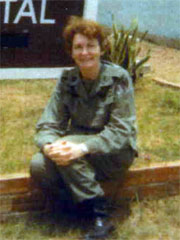 Valerie Buchan is from Henning, a small town in west central Minnesota. She knew as a young girl that she wanted to be a nurse, and in 1954 began her nurses’ training in Hamline University’s diploma program. After graduating in 1957, she spent the nine years nursing in the civilian field and absorbing the anti-communist messages of Cold War America. When the military nurse corps started recruiting nurses to serve in Vietnam, Valerie signed up. She believed in the fight against communism and had been raised in a family with a long tradition of military service. Most importantly, she wanted to use her nursing skills to help care for soldiers wounded in Vietnam. From 1966 to 1968, Valerie took care of wounded GIs who had been evacuated from Vietnam to Japan; then, in September, 1968, she arrived in Vietnam. She was assigned to the 12th Evacuation Hospital in Cu Chi, where she worked as head nurse in the Emergency Room. Valerie describes her patients as “wonderful people to take care of…our finest, finest
Valerie Buchan is from Henning, a small town in west central Minnesota. She knew as a young girl that she wanted to be a nurse, and in 1954 began her nurses’ training in Hamline University’s diploma program. After graduating in 1957, she spent the nine years nursing in the civilian field and absorbing the anti-communist messages of Cold War America. When the military nurse corps started recruiting nurses to serve in Vietnam, Valerie signed up. She believed in the fight against communism and had been raised in a family with a long tradition of military service. Most importantly, she wanted to use her nursing skills to help care for soldiers wounded in Vietnam. From 1966 to 1968, Valerie took care of wounded GIs who had been evacuated from Vietnam to Japan; then, in September, 1968, she arrived in Vietnam. She was assigned to the 12th Evacuation Hospital in Cu Chi, where she worked as head nurse in the Emergency Room. Valerie describes her patients as “wonderful people to take care of…our finest, finest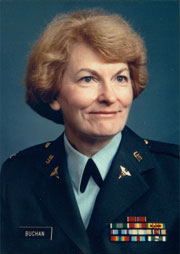 young men.” By the time she came home in the fall of 1969, she had begun to have doubts about the war, but was offended by the antiwar movement’s apparent focus on blaming the soldiers for the war. Valerie finished her active duty service at Ft. Devens in Massachusetts, where she had a chance to process her in-country experiences with others who had served in Vietnam. After leaving active duty in 1971, Valerie spent the next sixteen and a half years in the Reserves. She helped with the efforts to build the Vietnam Women’s Memorial and attended its 1993 dedication and five-, ten-, and fifteen-year anniversary celebrations.
young men.” By the time she came home in the fall of 1969, she had begun to have doubts about the war, but was offended by the antiwar movement’s apparent focus on blaming the soldiers for the war. Valerie finished her active duty service at Ft. Devens in Massachusetts, where she had a chance to process her in-country experiences with others who had served in Vietnam. After leaving active duty in 1971, Valerie spent the next sixteen and a half years in the Reserves. She helped with the efforts to build the Vietnam Women’s Memorial and attended its 1993 dedication and five-, ten-, and fifteen-year anniversary celebrations.
Valerie retired in 2000 after working in the nursing profession for 43 years. She lives in Arden Hills.
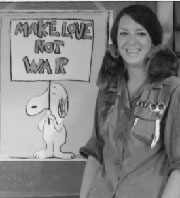 Mary Beth Crowley grew up in St. Paul and attended nursing school at the University of Minnesota. She joined the Student Nurse Program in December 1968. When she graduated from the University in June 1969, her father, a World War II veteran and Army Reserve officer, swore her in as a second lieutenant in the Army Nurse Corps. Her first duty station was at Walter Reed Army Medical Center in Washington, D.C. While working at Walter Reed, she witnessed the Vietnam Moratorium, a major antiwar demonstration that took place in October 1969. At the time, she says, she was in “the military mindset” and so wasn’t questioning the war. That changed shortly after she arrived in Vietnam in early 1970, however, as she began to wonder about the morality and prosecution of the war. She worked in a medical unit for a while, then transferred to a surgical unit. In addition to caring for wounded Americans, she also treated “the kids of war,” an experience for which she says she was not prepared. “Every time somebody died,” she says, “part of me died, too.” She and her colleagues coped with the emotional stress of their work by smoking, drinking, listening to music, playing games – by trying to create the comforts of home in the warzone. Mary Beth returned to the U.S. in February 1971 and was discharged from the service in June. She spent most of the rest of her professional career working at the VA Medical Center. She started talking about her experiences in Vietnam while working on behalf of the Vietnam Women’s Memorial Project, for which she served as the North Central Regional Coordinator.
Mary Beth Crowley grew up in St. Paul and attended nursing school at the University of Minnesota. She joined the Student Nurse Program in December 1968. When she graduated from the University in June 1969, her father, a World War II veteran and Army Reserve officer, swore her in as a second lieutenant in the Army Nurse Corps. Her first duty station was at Walter Reed Army Medical Center in Washington, D.C. While working at Walter Reed, she witnessed the Vietnam Moratorium, a major antiwar demonstration that took place in October 1969. At the time, she says, she was in “the military mindset” and so wasn’t questioning the war. That changed shortly after she arrived in Vietnam in early 1970, however, as she began to wonder about the morality and prosecution of the war. She worked in a medical unit for a while, then transferred to a surgical unit. In addition to caring for wounded Americans, she also treated “the kids of war,” an experience for which she says she was not prepared. “Every time somebody died,” she says, “part of me died, too.” She and her colleagues coped with the emotional stress of their work by smoking, drinking, listening to music, playing games – by trying to create the comforts of home in the warzone. Mary Beth returned to the U.S. in February 1971 and was discharged from the service in June. She spent most of the rest of her professional career working at the VA Medical Center. She started talking about her experiences in Vietnam while working on behalf of the Vietnam Women’s Memorial Project, for which she served as the North Central Regional Coordinator. 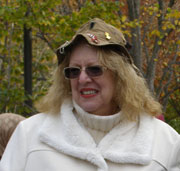
Mary Beth retired from the VAMC in 2003 after 35 years of service, including her Armytime. She currently works in hospice care and “ponders retirement every six months or so.” “One of these days,” she says.
A message from Mary Beth:
I would love to hear from anyone who was at the 17th Field or 8th Field Hospital in An Khe, 1970-71.
Penny Kettlewell grew up in a family that valued patriotic service: her father made a career of the Air Force and her grandmother had run a Mom’s Club in Detroit during World War II. She and her two brothers were raised on notions of “duty, honor, country,” and she felt called to service when President John F. Kennedy asked Americans to “ask what you can do for your country.” Penny joined the Army Student Nurse Program to help pay for her last year of nursing school in Detroit. She went to Ft. Sam Houston in the fall of 1966 and arrived in Vietnam in September 1967. At the 67th Evacuation Hospital in Qui Nhon, she worked in the Intensive Care and Receiving and Evacuation units. A good friend and fellow nurse, Hedwig Orlowski, was killed in a plane crash in November 1967. Though her year in-country was full of pressure, coming home to a divided country was even more stressful for Penny. In 1970, she returned to Vietnam for a second tour of duty. This time, she was stationed at the 24th Evacuation Hospital in Long Binh. She had seen signs of declining morale among troops during her first tour, but says the situation was far worse in 1970-71. Though she returned to the U.S. with serious criticisms of the war, she was equally chagrined by the antiwar movement at home. After she separated from the military, Penny decided to leave nursing and went to anesthesia school in Utah. She moved to Minnesota with some friends, eventually taking a job at St. Luke’s Hospital in Duluth. Penny describes the nurses’ PTSD group as “an absolute lifeline,” one that helped her deal with the flashbacks and nightmares that had interfered with her life and work. When her PTSD resurfaced in 2001, she sought assistance from the VA in St. Cloud, where she had a wonderful experience.
Penny retired from St. Luke’s in 2001 and now lives in north central Wisconsin, where she and two friends own and operate The Old Hen House Glass & Craft Shop. She says Vietnam is “somewhere way out in the back forty” of her life.
Lynn Kohl was raised in a Catholic family in Appleton, Wisconsin. During her senior year of nursing school in Milwaukee, a fellow student convinced her to visit an Army Nurse Corps recruiter. Lynn joined the ANC after the recruiter assured her that she would not be sent to Vietnam without her consent; she did not want to serve in the warzone. She was dismayed, therefore, when she received her orders in 1969. Despite her protestations, Lynn arrived in Vietnam in June 1969 and was assigned to the 71st Evacuation Hospital in Pleiku. Over the next twelve months, she became accustomed to the frequent enemy attacks that plagued her base, which was known as “Rocket City.” She would often wake up in the morning under her bed, having automatically sought shelter there during a nighttime attack. Lynn describes her work in the surgical unit as “overwhelming,” beginning with her first day on duty when she had to amputate a young soldier’s arm. She says that she came home from Vietnam in June 1970 a different person: stronger, perhaps, but also less joyful and trusting. She returned to Wisconsin, where she married and had two children. In 1982, she sought in-patient treatment for Post Traumatic Stress Disorder at a VA hospital, but left before completing the program because the trauma she had experienced as a nurse did not fit the paradigm of war trauma as it was understood at the time. Lynn’s healing began with her work on behalf of the Vietnam Women’s Memorial Project and continued with her participation in the nurses’ PTSD group. For three years, she drove from central Wisconsin to Minneapolis every week so she could partake of the burgeoning sisterhood.
Lynn went back to Vietnam in 2005. Though she came away with mixed feelings about the country and the legacy of U.S. involvement in its affairs, she was gratified to visit Pleiku and learn about the new, highly-regarded hospital that stands on the site of her former hospital. Lynn is retired and still lives in north central Wisconsin.
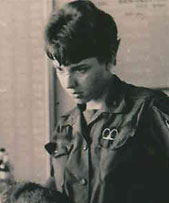 Joan Paulson was born in Duluth, Minnesota, and describes herself as a “happy-go-lucky kid.” Her Catholic family and teachers taught her to value faith, service, and patriotism. After high school, she attended the three-year nursing program at St. Mary’s in Rochester. She joined the Army Student Nurse Program in 1965 and graduated from nursing school in 1966. A product of many years of Catholic schooling, Joan had an easy time transitioning to life in the military. When she received her orders for Vietnam, however, she panicked; she had been working in obstetrics and felt unprepared to care for war-wounded patients. Nevertheless, she arrived in Vietnam in 1967 and was assigned to the 67th Evacuation Hospital, where she roomed with Penny Kettlewell. Joan worked in the orthopedic ward and a general surgical unit, treating patients with a variety of flesh wounds. She was in-country for the 1968 Tet Offensive and remembers the deafening explosion of a nearby ammunition dump and seeing tracers outside the hospital windows where she and her colleagues were working in blackout conditions. She separated from the military after fulfilling her two-year obligation, came back to Minnesota, got married and had two children. She practiced nursing in the mental health field for many years. Unlike many veterans, Joan didn’t have a particularly difficult time talking about her war experiences once she returned home, surrounded as she was by her supportive husband and friends. She became involved in the nurses’ PTSD group when Penny contacted her twenty years after they had been in Vietnam together.
Joan Paulson was born in Duluth, Minnesota, and describes herself as a “happy-go-lucky kid.” Her Catholic family and teachers taught her to value faith, service, and patriotism. After high school, she attended the three-year nursing program at St. Mary’s in Rochester. She joined the Army Student Nurse Program in 1965 and graduated from nursing school in 1966. A product of many years of Catholic schooling, Joan had an easy time transitioning to life in the military. When she received her orders for Vietnam, however, she panicked; she had been working in obstetrics and felt unprepared to care for war-wounded patients. Nevertheless, she arrived in Vietnam in 1967 and was assigned to the 67th Evacuation Hospital, where she roomed with Penny Kettlewell. Joan worked in the orthopedic ward and a general surgical unit, treating patients with a variety of flesh wounds. She was in-country for the 1968 Tet Offensive and remembers the deafening explosion of a nearby ammunition dump and seeing tracers outside the hospital windows where she and her colleagues were working in blackout conditions. She separated from the military after fulfilling her two-year obligation, came back to Minnesota, got married and had two children. She practiced nursing in the mental health field for many years. Unlike many veterans, Joan didn’t have a particularly difficult time talking about her war experiences once she returned home, surrounded as she was by her supportive husband and friends. She became involved in the nurses’ PTSD group when Penny contacted her twenty years after they had been in Vietnam together.
Joan retired in 2007, after spending 38 years at Health East. She and her husband have two sons, of whom they are very proud, and four delightful grandchildren (three granddaughters and one grandson). She is currently enjoying volunteering, social justice work, and travel. She says that Vietnam is “just one of the ingredients” that has made her who she is and that has led her to her current work on matters of social justice.
A message from Joan:
Faith, family, and friends have been the solid foundation in my life. I am especially grateful to my husband, Dennis, who has always been there for me.
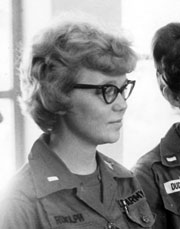 Ann Rudolph grew up in the Chicago area in a family that valued its Lutheran faith. Both of her parents had earned degrees from St. Olaf College in Northfield, Minnesota, and it was expected that Ann and her two younger brothers would pursue college educations as well. Ann began studying nursing at St. Olaf after graduating from high school in 1960. She joined the Army Nurse Corps through its Student Nurse Program not only to take advantage of its tuition benefits, but also to have “an adventure.” Both of her parents – especially her father, who had been a Marine – were proud of her decision to serve her country. She graduated from St. Olaf in 1964 and was commissioned into the Army Nurse Corps. During the early months of her Army life, Ann worked at Walter Reed Army Medical Center in Washington, D.C. In addition to her nursing duties, she also served as a model for the Army Nurse Corps’ promotional materials. Although she did not volunteer for duty in Vietnam, she accepted her assignment as part of the requirements of her job, despite the fact that it meant a long separation from her new husband. She traveled to Vietnam by ship, arriving in September 1965. She was assigned to the 93rd Evacuation Hospital in Long Binh, where she worked in the surgical and medical wards. Ann says that, in addition to providing medical care to her patients, she also tried to “bring a little home to them, smile at them, pay attention to them, give them time.” When she returned to the U.S. in 1966, she tried to put Vietnam behind her and resume life as a newlywed. She and her husband had two children, a daughter and a son. Before she and her husband divorced, Ann saw a number of counselors and told each of them that she had served in Vietnam. None of them, she says, ever contemplated the possibility that her war service had anything to do with the issues for which she sought counseling. It wasn’t until she met the other women in the nurses’ PTSD group run by Kay Ryan that she began to see how Vietnam had affected her, and to heal. “The empathy of that group,” she says, “…absolutely cemented me to all those gals.” She was in Washington, D.C., for the dedication of the Vietnam Women’s Memorial in 1993, noting that she hadn’t realized how much she had needed the “welcome home” that the celebration of the Memorial provided.
Ann Rudolph grew up in the Chicago area in a family that valued its Lutheran faith. Both of her parents had earned degrees from St. Olaf College in Northfield, Minnesota, and it was expected that Ann and her two younger brothers would pursue college educations as well. Ann began studying nursing at St. Olaf after graduating from high school in 1960. She joined the Army Nurse Corps through its Student Nurse Program not only to take advantage of its tuition benefits, but also to have “an adventure.” Both of her parents – especially her father, who had been a Marine – were proud of her decision to serve her country. She graduated from St. Olaf in 1964 and was commissioned into the Army Nurse Corps. During the early months of her Army life, Ann worked at Walter Reed Army Medical Center in Washington, D.C. In addition to her nursing duties, she also served as a model for the Army Nurse Corps’ promotional materials. Although she did not volunteer for duty in Vietnam, she accepted her assignment as part of the requirements of her job, despite the fact that it meant a long separation from her new husband. She traveled to Vietnam by ship, arriving in September 1965. She was assigned to the 93rd Evacuation Hospital in Long Binh, where she worked in the surgical and medical wards. Ann says that, in addition to providing medical care to her patients, she also tried to “bring a little home to them, smile at them, pay attention to them, give them time.” When she returned to the U.S. in 1966, she tried to put Vietnam behind her and resume life as a newlywed. She and her husband had two children, a daughter and a son. Before she and her husband divorced, Ann saw a number of counselors and told each of them that she had served in Vietnam. None of them, she says, ever contemplated the possibility that her war service had anything to do with the issues for which she sought counseling. It wasn’t until she met the other women in the nurses’ PTSD group run by Kay Ryan that she began to see how Vietnam had affected her, and to heal. “The empathy of that group,” she says, “…absolutely cemented me to all those gals.” She was in Washington, D.C., for the dedication of the Vietnam Women’s Memorial in 1993, noting that she hadn’t realized how much she had needed the “welcome home” that the celebration of the Memorial provided.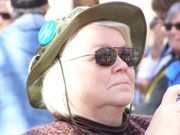
Ann is now enjoying her retirement and the time she can
spend with her family in Olivia, Minnesota.
A message from Ann:
I hope this book will help all the readers understand our role in Vietnam!
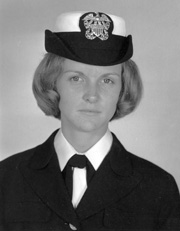 Mary O’Brien Tyrrell grew up in Superior, Wisconsin. She was one of seven children in her family. She joined the Navy Nurse Corps midway through her four-year nursing program at the College of St. Scholastica in Duluth. In August 1964, she and a fellow nursing student traveled to Greenwood, Mississippi, to provide medical care to the African American community during Freedom Summer. They arrived on the day the bodies of slain civil rights activists James Chaney, Andrew Goodman, and Michael Schwerner were discovered in the ditch in Philadelphia, Mississippi. They spent a month working in the ghetto in Greenwood, returning home in time for classes that fall. Mary began her fulltime work in the Navy Nurse Corps after she graduated in 1965. She volunteered to go to Vietnam, but was told she was too young. Instead, Navy officials told her she could go to USNHGuam, MI, if she extended her duty an extra six months, which she did. She arrived on Guam in June 1967 and left in December 1968. While there, she served as head nurse on the D-2 U.S.N.H., which became the Air Evac Unit, a concept that she initiated shortly after arrival. During her eighteen months of service on Guam, she and her colleagues cared for 18,000 wounded servicemen, most of whom were Marines. After she returned from Guam, she learned to be silent about her experiences during the war…until she began writing poetry in 1984.
Mary O’Brien Tyrrell grew up in Superior, Wisconsin. She was one of seven children in her family. She joined the Navy Nurse Corps midway through her four-year nursing program at the College of St. Scholastica in Duluth. In August 1964, she and a fellow nursing student traveled to Greenwood, Mississippi, to provide medical care to the African American community during Freedom Summer. They arrived on the day the bodies of slain civil rights activists James Chaney, Andrew Goodman, and Michael Schwerner were discovered in the ditch in Philadelphia, Mississippi. They spent a month working in the ghetto in Greenwood, returning home in time for classes that fall. Mary began her fulltime work in the Navy Nurse Corps after she graduated in 1965. She volunteered to go to Vietnam, but was told she was too young. Instead, Navy officials told her she could go to USNHGuam, MI, if she extended her duty an extra six months, which she did. She arrived on Guam in June 1967 and left in December 1968. While there, she served as head nurse on the D-2 U.S.N.H., which became the Air Evac Unit, a concept that she initiated shortly after arrival. During her eighteen months of service on Guam, she and her colleagues cared for 18,000 wounded servicemen, most of whom were Marines. After she returned from Guam, she learned to be silent about her experiences during the war…until she began writing poetry in 1984.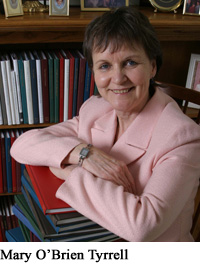
Mary currently lives in St. Paul, where for the last eighteen years she has assisted olderpeople to publish their life stories in limited-edition hardcover books to distribute at a family book-signing party. (See MemoirsInc.com.) She recently wrote a book instructing others how they might do the same service for their community: Become a Memoirist for Elders: Create a Successful Home Business.
A message from Mary:
To all my fellow veterans:
Thank you for your service. My three-and-a-half years of active duty are one of the highlights of my life. My only regret is that Vietnam was not the final war for the U.S.A. I had hoped that it would be.
Beyond Sisterhood of War: They Also Served
Lucie Ferrell joined the Navy Nurse Corps in 1965 while in nursing school at the College of St. Catherine in St. Paul, Minnesota. The Student Nurse Program paid for her final year of college, in return for which Lucie gave the NNC two years. She was stationed in San Diego at the US Naval Hospital, which was a receiving hospital for Marines and Navy personnel who had been wounded in Vietnam. LTJG Ferrell cared for general surgery patients plus those with eye injuries, burns, and those in need of GI surgery and plastic reconstructive surgery. She describes her experiences caring for the war’s wounded in a poem entitled “Memorial Day.” [PDF]
A message from Lucie:
The Naval Hospital at San Diego had the Corps School where the enlisted men and women were trained as corpsmen and corpswaves prior to being assigned to USN Hospitals around the country or to the US Marines in Vietnam. They staffed ourunits while waiting for their FMF orders (Fleet Marine Forces). It scared us all! San Diego received patients who had been stabilized on the hospital ships (USS Repose and USS Sanctuary) and who needed acute care and rehabilitative services. It was in San Diego that they "woke up" with body parts and abilities gone forever; where they had to face their new reality of loss; where their girlfriends and wives and parents discovered that this was a different person, one with whom they now had to try and establish a new relationship; where they learned first-hand just how unwelcome they were back home now and even were taunted for doing what they thought was the right thing to do. In so many ways, it was truly a great experience for me yet, in so many ways, it was truly a great, great challenge for a young, naïve new graduate and inexperienced nurse – and Naval Officer. Mostly, I am very glad I did it though.
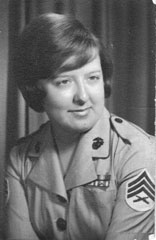 Mary Glaudel-DeZurik served in the Marine Corps from January 4, 1966, through December 12, 1968. From August 28, 1967, to August 15, 1968, Sgt. Glaudel worked in administration at Military Assistance Command, Vietnam. Here’s what Mary says about her service:
Mary Glaudel-DeZurik served in the Marine Corps from January 4, 1966, through December 12, 1968. From August 28, 1967, to August 15, 1968, Sgt. Glaudel worked in administration at Military Assistance Command, Vietnam. Here’s what Mary says about her service:
I enlisted in the Marine Corps in January 1966. My first duty station was in Washington D.C. at the Marine Corps Institute. I loved this job and would have been content to stay there for my entire three-year enlistment had it not been for the opportunity to serve in Vietnam. I wanted to be able to contribute to the war effort and help our men in the field. I volunteered at the first opportunity and, with my CO’s recommendation, received my orders to go overseas. I arrived in Saigon in August 1967. My first impression was how very hot and humid it was. I was assigned to HQ MACV, Mail and Distribution. My job was to receive incoming mail – reports, documents, maps, etc. -- from the various Pacific commands and distribute it throughout the HQ. Any of the documents classified as “secret” required a special tracking procedure. For six weeks I also maintained a piaster exchange booth converting the Military Pay Currency (MPC) into piasters. The 1968 Tet Offensive happened right in the middle of my tour. Everything changed at that point. Before Tet, we wore our uniform dress; after Tet, we wore fatigues and combat boots, a more comfortable and practical option since we were in a combat zone. The 11-12 hour days got longer and time off was rare. The Tet Offensive impacted my job tremendously since planes were not landing at TanSon Nhut air base for a period of time, which meant that my mail backed up. When it started arriving again, I routinely worked twelve to thirteen hours a day, sometimes more. There were no days off until the middle of April. After I left Vietnam inAugust 1968, I finished the remaining three months of my enlistment at the Marine Corps Recruit Depot in San Diego in the Women Marine Company office. I was discharged on December 12, 1968, and returned to Minnesota where I met and married Peter DeZurik. After raising four children, I worked at the Minnesota Pollution Control Agency for 25 years, retiring in January 2013.
My tour in Vietnam taught me many things. I was, and am, extremely grateful to be born and live in this country where our liberties are so often taken for granted. I can’t, and won’t, take for granted the good men and women who serve our country every day, many under difficult conditions. They are my heroes.
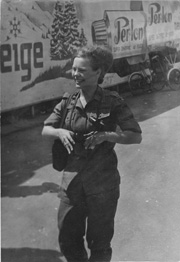 Jennifer Wilson grew up in St. Paul, Minnesota. She was very conservative in her outlook, and because she was bothered by the activities of her peers during the mid-sixties, decided to hold her own demonstration by joining the military and going to Vietnam. She participated in the Army Student Nurse Program while a nursing student at the University of Minnesota. After graduation, she attended basic training at Fort Sam Houston, TX, and then the Operating Room Nursing Course at Letterman General Hospital in San Francisco. While in this course, she volunteered for Vietnam and arrived on her 24th birthday. She remembers celebrating her birthday with a greasy hamburger and french fries at the 90th Replacement Depot in Long Binh. She was assigned to the 3rd Field Hospital in Saigon, where she worked in the operating room from June 1969 to June 1970. After returning to the United States, she was assigned to the operating room at the US Army Hospital at Fort Benjamin Harrison in Indianapolis and at William Beaumont General Hospital in El Paso, Texas, where she left active duty. She then served 24 years in the reserves with assignments in nursing service and in unit-level training. She retired from the Army with the rank of Colonel in 1995.
Jennifer Wilson grew up in St. Paul, Minnesota. She was very conservative in her outlook, and because she was bothered by the activities of her peers during the mid-sixties, decided to hold her own demonstration by joining the military and going to Vietnam. She participated in the Army Student Nurse Program while a nursing student at the University of Minnesota. After graduation, she attended basic training at Fort Sam Houston, TX, and then the Operating Room Nursing Course at Letterman General Hospital in San Francisco. While in this course, she volunteered for Vietnam and arrived on her 24th birthday. She remembers celebrating her birthday with a greasy hamburger and french fries at the 90th Replacement Depot in Long Binh. She was assigned to the 3rd Field Hospital in Saigon, where she worked in the operating room from June 1969 to June 1970. After returning to the United States, she was assigned to the operating room at the US Army Hospital at Fort Benjamin Harrison in Indianapolis and at William Beaumont General Hospital in El Paso, Texas, where she left active duty. She then served 24 years in the reserves with assignments in nursing service and in unit-level training. She retired from the Army with the rank of Colonel in 1995.
After Jennifer left active duty, she enrolled in graduate programs in nursing at Russell Sage College in Troy, NY, and at Teachers College, Columbia University in New York City. She finished her doctoral study in 1976. She later did additional graduate work in measurement and evaluation for nursing, also at Teachers College. Her professional career outside of the military was largely in higher education where she served as Dean of Nursing at Grand Canyon University in Phoenix, Arizona, and at Southwest Baptist University in Springfield, Missouri. She retired in 2008. 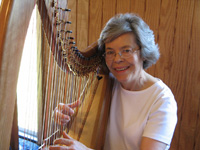
Jennifer has always loved music and began taking harp lessons in 2006. She later enrolled in the “Heart of God Harpers” program to prepare harpists to play clinically at the bedside. She now volunteers in hospice by playing her harp at the bedside. She sees this as a ministry and feels so privileged to be able to share in this aspect of her patient’s lives.
